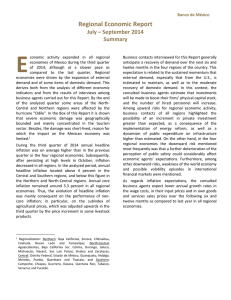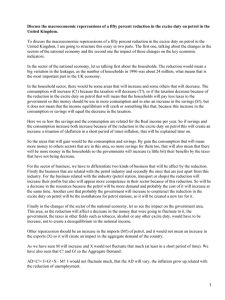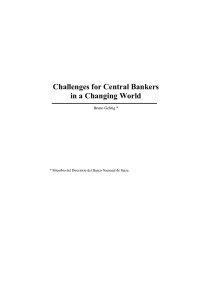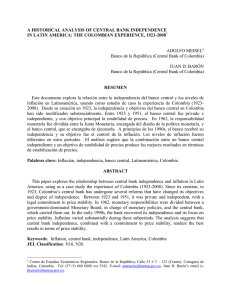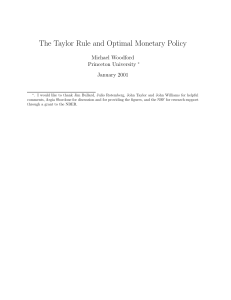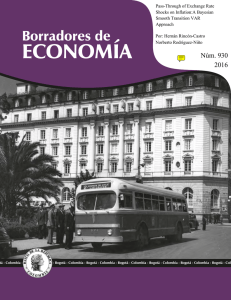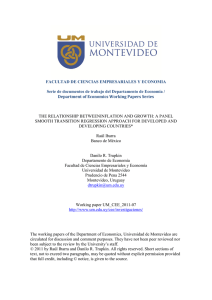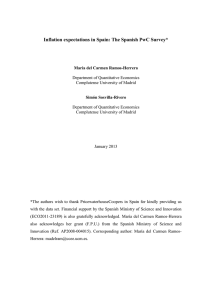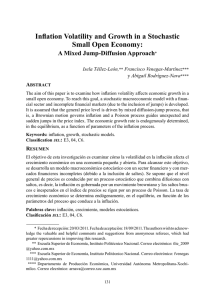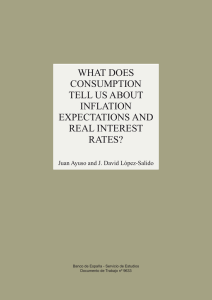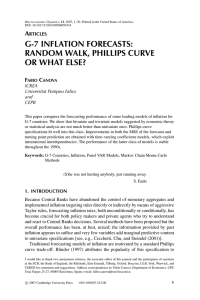The Colombian Economy and Monetary Policy Jose Dario Uribe
Anuncio
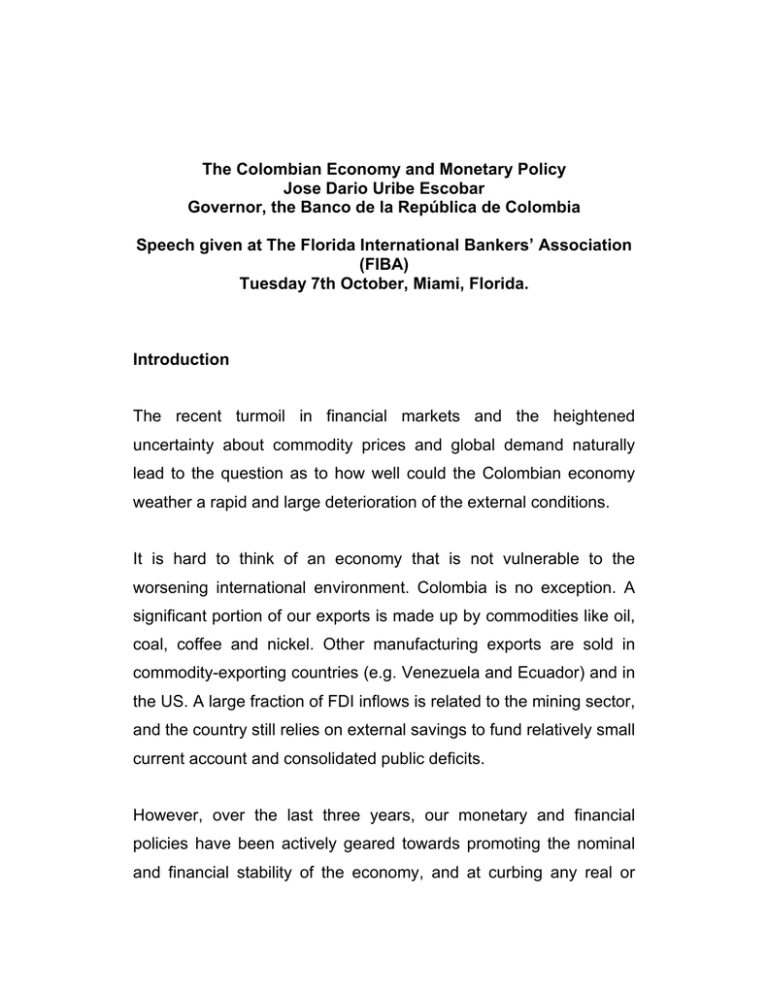
The Colombian Economy and Monetary Policy Jose Dario Uribe Escobar Governor, the Banco de la República de Colombia Speech given at The Florida International Bankers’ Association (FIBA) Tuesday 7th October, Miami, Florida. Introduction The recent turmoil in financial markets and the heightened uncertainty about commodity prices and global demand naturally lead to the question as to how well could the Colombian economy weather a rapid and large deterioration of the external conditions. It is hard to think of an economy that is not vulnerable to the worsening international environment. Colombia is no exception. A significant portion of our exports is made up by commodities like oil, coal, coffee and nickel. Other manufacturing exports are sold in commodity-exporting countries (e.g. Venezuela and Ecuador) and in the US. A large fraction of FDI inflows is related to the mining sector, and the country still relies on external savings to fund relatively small current account and consolidated public deficits. However, over the last three years, our monetary and financial policies have been actively geared towards promoting the nominal and financial stability of the economy, and at curbing any real or 2 financial excesses that could increase its fragility. Monetary policy reacted in time to early signs of excessive expenditure by the private sector, the credibility of a low inflation regime was enhanced, the external liquidity of the country was enlarged, the threat of unsustainable, low quality credit growth was eliminated, and regulation of market and credit risk in the financial system was strengthened. All these actions have significantly reduced the vulnerability of the Colombian economy in the face of any deterioration of external conditions that we will come to face and so increased the degrees of freedom for policy responses. Our recent monetary policy history Let me describe the process through which these actions were taken. Following a deep and protracted recession in the beginning of the decade, the domestic and external conditions of the Colombian economy experienced continuous improvement since 2004. Consumer and business confidence increased with the progress in security, while external demand and terms of trade picked up (Graphs 1 and 2). As a result, foreign and domestic investment jumped (Graphs 3 and 4), and output and domestic demand growth doubled in the period 2004-2007 with respect to 2000-2003 (Graph 5). Credit expanded rapidly after years of negative growth rates, following the financial crisis of 1998-1999 (Graph 6). Also, the currency appreciated in real terms after 2003 (Graph 7). Inflation declined along the targets throughout the decade (Graph 8), aided by the appreciation of the currency and by the presence of a negative output gap that we 3 inherited from the recession and kept thanks to the increased investment and productivity. The policy response to these events was two-pronged: We kept real interest rates low (Graph 9) and decided to accumulate international reserves. The first part was justified on the grounds of the existence of a negative output gap and the observed and forecasted fulfillment of the inflation targets. The accumulation of reserves was aimed at building up the international liquidity position of the economy, under uncertainty about the persistence of favorable external conditions. In addition, intervention in the FX market tried to smooth the appreciation process. The two components of the policy response were consistent in the sense that keeping low interest rates was coherent with the purchases of hard currency by Banco de la República. Nevertheless, by early 2006 there were signs of overheating in the economy, even though inflation had reached its lowest point in decades. Hence, we started a tightening cycle from low levels of the real interest rate. Initially, the effects of the increases in the central bank interest rate were muted by a credit supply shock that followed a sharp shift in the financial intermediaries´ asset portfolio (Graph 10). The large increase in loan supply not only put the inflation target at risk, but also threatened financial stability, as banks tend to loosen standards amid rapid credit expansion and abundant liquidity. The Financial Superintendency responded by increasing provisioning requirements on commercial and consumer loans, as 4 well as adopting tougher systems of administration of credit risk for both types of loans. Early on, regulation of market risk had been improved. At the same time, Banco de la República imposed marginal reserve requirements on bank deposits, aiming at reinforcing the transmission of the interest rate hikes and curbing excessive credit growth. In retrospect, these were timely and adequate measures, for the demand pressures on inflation were building very fast, as illustrated by the increase in “non-tradable” inflation by more than 100 bps between September 2006 and September 2007 (Graph 11). These are the subcomponents of the CPI that closely reflect the impact of domestic aggregate demand on prices. Also, an analysis of “vintages” of consumer loans shows a clear drop in credit quality between 2006 and 2007 that has started to improve again in 2008 (Graph 12). Foreign exchange policy involved discretionary intervention of Banco de la República in the FX market since late 2004. In 2007 it was clear that the tightening of monetary policy was not consistent with discretionary purchases of dollars by the central bank and that inflation control could be hindered if FX intervention cast any doubt on the resolve of the central bank to reach the inflation targets. Hence, discretionary intervention was abandoned. Instead, capital controls were introduced to alleviate the appreciating pressure on the currency and as a complement of the marginal reserve requirements established by the same time. Purchases of international reserves were resumed later in 2008 to enhance the external liquidity position of the country, in the face of increased 5 uncertainty about the external conditions. However, this time the purchases were made through “rules-based” mechanisms that minimize the conflict or appearance of conflict with monetary policy. Price shocks hit the Colombian economy in 2007 and 2008. Some were idiosyncratic, like weather-related jumps in food prices or increases in the prices of some food items that were scarce in neighboring Venezuela. Other shocks were part of the global rise in the relative prices of food, energy and raw materials. In 2007 the idiosyncratic shocks and the demand pressures pushed inflation above target. International prices also contributed to this result, but their effect was largely compensated by the appreciation of the currency. In 2008, however, the impact of the international price shocks has been so sharp, that the appreciation of the peso during the first semester was not sufficient to prevent substantial increases in the local food and energy prices, as well as in producers´ costs, as illustrated by the behavior of PPI inflation (Graph 13). The macroeconomic results of these shocks are visible in the economic data for the first semester of this year. On the one hand, CPI inflation rocketed and deviated substantially from its target (Graph 8). On the other hand, the economy slowed down from the high growth rates it reached in the previous two years, driven down especially by a contraction in private consumption growth (Table 1). The slowdown is in part an outcome that we were pursuing, since the high growth rates of domestic demand observed throughout 2006 and 2007 were not sustainable in the long run. Thus, the deceleration is partially the result of past monetary policy actions. 6 However, not all the slackening in the pace of economic activity can be attributed to monetary policy. Some of the price shocks may be understood as a supply shock that simultaneously increases prices and reduces output, by raising the production costs of firms or cutting real disposable income of households. These channels appear to be quite important in Colombia, as illustrated by the increase in PPI inflation already noted (Graph 13) and by the fact that around 39% of the CPI basket is represented by items whose relative prices has risen fast recently (food, transportation, fuel and public utilities) (Graphs 14 and 15). The deceleration in economic activity is also explained by a decline in local governments´ fixed investment related to their post-electoral cyclical behavior, and by a moderation in manufacturing and agricultural exports due to the global slowdown and trade restrictions imposed by the government of Venezuela. The sharp increase in CPI inflation during 2008 pushed up inflation expectations or inflation risk premia in the short and in the long run (Graph 16). Thus the macroeconomic situation we faced by mid 2008 was characterized by increasing inflation and inflation expectations, a slowdown of economic activity from unsustainably high levels and cost pressures. Looking forward, it was clear that the main risk for the economy was if that the inflationary shock were to become permanent. If we allow what is originally a large, temporary rise in relative food prices to become a generalized inflationary spiral, we would seriously damage Colombia’s growth and economic fundamentals. One mechanism for this would be through our labour markets, where any 7 attempt to raise wages above productivity to compensate for relative price movements would generate not just further bouts of inflation but also structural unemployment and large falls in output. Therefore, interest rates were raised again in July to signal Banco de la República´s intention to drive inflation back toward the long term 2%-4% target. The response of the market was impressive. After the decision was made, the zero-coupon public bond curve shifted down by an average of 90 bps at 5 to 15 years maturities and has stayed low since (Graph 17). In sum, since 2006, the Banco de la República has raised its interest rates by 400 bps, imposed marginal reserve requirements on deposits and accumulated international reserves for US$ 8.7 billion. These measures have definitely improved the ability of the Colombian economy to withstand adverse effects coming from the international turbulence. Let me explain how. First, as a result of the monetary policy actions, the annual change of CPI excluding food and regulated prices remained below 4% in 2007 and 2008, and has recently started to go down (Graph 18). This has left us in a position to reduce inflation in the absence of further large relative price movements. Moreover, it has helped consolidate the credibility of the inflation targeting regime and could reduce the pass-through of a large depreciation that may follow a deterioration of international conditions. Second, in the event of an adverse external shock, the accumulation of international reserves has several benefits from the macro and 8 financial point of view. Given the still imperfect credibility of the inflation targets and the indexation prevailing in the labor market, it gives the central bank another tool to deal with a large depreciation of the currency. Also, it provides a signal about the international liquidity of the country that may prove useful to deter attacks on the currency or the deposits of the financial system. Third, as mentioned, the combined measures of Banco de la República and the Financial Superintendency induced a fall in credit growth and an improvement in the quality of lending (Graphs 6 and 12). This set the expenditure patterns of the private sector on sustainable paths, cut excessive leverage by firms and households, and left the financial system with a good capital base to absorb the effects of adverse external events. You will find a profound analysis of our financial sector and its risks and exposures in our Financial Stability which has just been published and is on our website. Conclusion In summary, our fundamentals are good, and in some very important areas, have improved in recent years. Of course the current high levels of inflation and slower growth in Colombia are of concern to us. On top of this, we are all facing a great uncertainty about what it is going to happen to world markets. Our strategy will be to continue improving these fundamentals. One important aspect of this is to ensure that inflation moves back towards its target. 9 Graph 1 Real GDP Growth of Colombia's trading partners 7,0 6,0 4,0 3,0 2,0 1,0 0,0 -1,0 2000 2001 2002 2003 2004 2005 2006 2007 GDP of Colombia's Trading Partners Source: WEO, calculations of Banco de la República 2008 proy *Trading partner's GDP weighed by global commerce Graph 2 Terms of Trade* 160 150 140 130 120 110 100 90 * Calculated using producer's price index. It is defined as the ratio between the exported price index and the imported price index Source: Banco de la República Jan-08 Jan-07 Jan-06 Jan-05 Jan-04 Jan-03 Jan-02 Jan-01 Jan-00 Jan-99 Jan-98 Jan-97 Jan-96 Jan-95 Jan-94 Jan-93 Jan-92 Jan-91 80 Jan-90 Percentage 5,0 10 Graph 3 Composition of FDI in Colombia by Sectors Millions of dollars 9800 8800 7800 6800 5800 4800 3800 2800 1800 800 -200 2002 2003 Other Sectors 2004 2005 Mining Sector 2006 2007 2008 py Purchases of Private and Public Companies Source: Banco de la República Graph 4 Percentage Investment/GDP ratio 30 28 26 24 22 20 18 16 14 12 10 1997 1998 1999 2000 2001 2002 2003 2004 2005 2006 2007 11 Graph 5 Annual Change of GDP and Internal Demand 15 10 Porcentage 5 0 -5 -10 GDP Internal Demand Graph 6 Total Gross Real Credit Annual Growth Rate 30,0% 20,0% 10,0% 0,0% -10,0% -20,0% Aug00 Total Credits deflated by CPI Aug01 Aug02 Aug03 Aug04 Aug05 Aug06 Aug07 Aug08 Jun-08 Sep-07 Dec-06 Mar-06 Jun-05 Sep-04 Dec-03 Mar-03 Jun-02 Sep-01 Dec-00 Mar-00 Jun-99 Sep-98 Dec-97 Mar-97 -15 12 Graph 7 Real Exchange Rate Index deflated by CPI 1994=100 160 140 120 100 80 60 Aug-90 Aug-92 Aug-94 Aug-96 Aug-98 Aug-00 Aug-02 Aug-04 Aug-06 Aug-08 Graph 8 Annual Inflation (CPI) and Inflation Target 11,0 10,0 9,0 8,0 6,0 5,0 4,0 Inflation Target Sep-08 Ene-08 May-07 Sep-06 Ene-06 May-05 Sep-04 Ene-04 May-03 Sep-02 Ene-02 May-01 Sep-00 3,0 Ene-00 % 7,0 13 Graph 9 Real Deposit Interest Rate (CD's) Deflated by CPI without food 6,0% 5,0% 4,0% 3,0% 2,0% 1,0% 90 days CD's A u g -0 8 F e b -0 8 A u g -0 7 F e b -0 7 A u g -0 6 F e b -0 6 A u g -0 5 F e b -0 5 A u g -0 4 F e b -0 4 A u g -0 3 F e b -0 3 A u g -0 2 F e b -0 2 A u g -0 1 0,0% Average since 1986 Graph 10 Investments /Total Assets Apr-08 Jan-07 Oct-05 Jul-04 Apr-03 Loans / Total Assets Investments /Total Assets 35,0% 32,0% 29,0% 26,0% 23,0% 20,0% 17,0% 14,0% 11,0% 8,0% 5,0% 70,0% 68,0% 66,0% 64,0% 62,0% 60,0% 58,0% 56,0% 54,0% 52,0% 50,0% Jan-02 Loans / Total Assets Loans and Investments / Total assets 14 Graph 11 Annual CPI Inflation 6,0 5,5 5,0 4,5 Sep-08 Jul-08 May-08 Mar-08 Jan-08 Nov-07 Sep-07 Jul-07 May-07 Mar-07 Jan-07 Nov-06 Sep-06 Jul-06 May-06 Mar-06 Jan-06 4,0 Non Tradable CPI without foodstuffs and administered prices Source: DANE, Calculations Banco de la República Graph 12 Loans at risk/Total Loans by vintages: Consumer loans 18% 16% 14% 12% 10% 8% 6% 4% 2% 0% Semester 1 Semester 2 2006 - I Semester 3 2006 - II 2007 - I Semester 4 2007 - II 2008 - I Semester 5 15 Graph 13 Producer's Price Index (annual change) Table 1 Annual GDP Growth by Type of Expenditure 2006 2007 2008-I 2008-II Total Consumption Private Consumption Public Consumption Gross Investment 6.0 6.5 4.2 19.2 6.5 6.7 5.9 20.6 3.3 3.4 3.1 13.1 2.8 3.1 1.7 8.4 Gross Fixed Investment Change in Inventories Exports Imports 17.2 37.0 7.5 16.2 17.5 45.0 11.9 19.0 8.1 48.1 14.1 15.4 7.8 11.7 11.6 10.5 GDP Internal Demand Internal Demand without Change in Inventories 6.8 8.7 8.1 7.7 9.7 8.8 4.5 5.7 4.4 3.7 4.2 3.9 Jul-08 Jan-08 Jul-07 Jan-07 Jul-06 Jan-06 Jul-05 Jan-05 Jul-04 Jan-04 Jul-03 Jan-03 Jul-02 Jan-02 Jul-01 Jan-01 Jul-00 Jan-00 18,0% 16,0% 14,0% 12,0% 10,0% 8,0% 6,0% 4,0% 2,0% 0,0% -2,0% -4,0% Source: DANE Total Administered Prices Sep-08 Jul-08 Foodstuffs May-08 Mar-08 Jan-08 Nov-07 Sep-07 Jul-07 Total May-07 Mar-07 Jan-07 Nov-06 Sep-06 Jul-06 May-06 Mar-06 Jan-06 Sep-08 Jul-08 May-08 Mar-08 Ene-08 Nov-07 Sep-07 Jul-07 May-07 Mar-07 Ene-07 Nov-06 Sep-06 Jul-06 May-06 Mar-06 Ene-06 16 Graph 14 Annual Consumer's Inflation 15,0 13,0 11,0 9,0 7,0 5,0 3,0 Source: DANE. Graph 15 Annual CPI Inflation 11,0 9,0 7,0 5,0 3,0 17 Graph 16 Monthly average of Inflation Expectations derived for Government Bonds (TES) 1, 5 y 10 years, January 2005 to September 2008† 9% 8% 7% 6% 5% 4% 1 year 5 years 10 years Observed Inflation Graph 17 Public bonds zero coupon curves 2008 13,25% 13,00% 12,75% 12,50% 12,25% 12,00% 11,75% 11,50% 11,25% 11,00% 10,75% 10,50% 10,25% 10,00% 1 2 3 4 5 25-Jul* 6 7 8 9 10 01-Sep** 11 Sep-08 Jul-08 May-08 Mar-08 Jan-08 Nov-07 Sep-07 Jul-07 May-07 Mar-07 Jan-07 Nov-06 Sep-06 Jul-06 May-06 Mar-06 Jan-06 Nov-05 Sep-05 Jul-05 May-05 Mar-05 Jan-05 3% 18 Graph 18 Annual CPI Inflation 4,0 3,9 3,8 3,7 3,6 CPI without foodstuffs and administered prices Source: DANE, Calculations Banco de la República Sep-08 Jul-08 May-08 Mar-08 Jan-08 Nov-07 Sep-07 Jul-07 May-07 Mar-07 Jan-07 3,5
